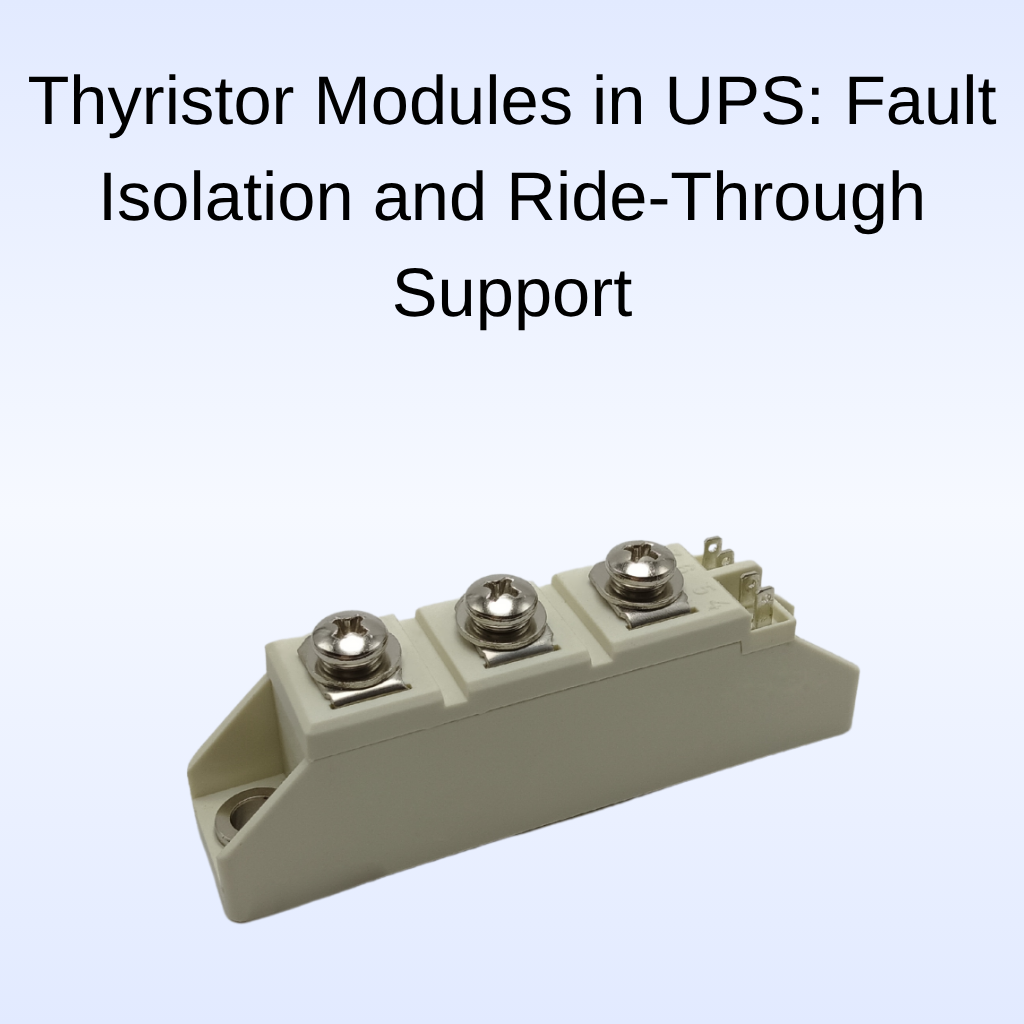1. Introduction: Enhancing UPS Resilience and Control with Thyristor Modules
In critical power setups, UPS systems must deliver high resilience, flexible control, and graceful degradation under faults. Advanced thyristor modules enable this by combining superior conduction, modulation, and protection. A module featuring ultra low VT desalination smart grid High surge current low on‑state voltage industrial phase control dual thyristor module capabilities ensures that even under stress, conduction losses remain minimal and performance stable. For battery-fed UPS, combining soft-start battery charger temperature control High surge current low on‑state voltage industrial phase control dual thyristor module allows safe ramp-up, thermal feedback, and surge tolerance. When interacting with DC grids or power houses, modules with HVDC power factor diming High surge current low on‑state voltage industrial phase control dual thyristor module offer active control in hybrid architectures. In this article, we explore fault containment, selective isolation, coordinated switching, and ride-through strategies.
2. Fault Containment and Selective Isolation
2.1 Isolating Faulty Branches
In modular UPS designs, faults may occur in one branch while others remain healthy. Thyristor modules with ultra low VT desalination smart grid High surge current low on‑state voltage industrial phase control dual thyristor module properties can isolate the faulty path with minimal voltage disruption and avoid disturbance to the rest of the system. Their low conduction drop ensures that switching does not induce large transients.
2.2 Controlled Disconnection
When fault detection triggers a disconnection, a soft-start battery charger temperature control High surge current low on‑state voltage industrial phase control dual thyristor module module can ramp down conduction gracefully before fully isolating the path. This soft disconnection minimizes voltage spikes, reduces stress on upstream and downstream equipment, and provides safer transitions.
2.3 Coordinated Switching with Phase Control
Using HVDC power factor diming High surge current low on‑state voltage industrial phase control dual thyristor module modules in a coordinated fashion allows synchronization of switching events across branches, even under fault conditions. By modulating phase angles, these modules can minimize inrush and synchronize transitions, ensuring that switching is smooth and non-disruptive.
3. Ride‑Through & Surge Absorption Strategies
3.1 Ride‑Through Support During Disturbances
UPS systems must sustain operation during grid disturbances or transient events. Modules with ultra low VT desalination smart grid High surge current low on‑state voltage industrial phase control dual thyristor module capability can absorb or clamp large transient currents while maintaining low conduction paths, contributing to ride-through capability.
3.2 Surge Absorption in Battery Interfaces
Switching to or from battery interface can induce surges. A soft-start battery charger temperature control High surge current low on‑state voltage industrial phase control dual thyristor module module handles these surges safely, ramping current and protecting the downstream equipment. Its temperature-aware design also helps dissipate transient heat peaks.
3.3 Dimming Surges via Phase Modulation
In hybrid setups, HVDC power factor diming High surge current low on‑state voltage industrial phase control dual thyristor module modules can modulate phase or load to “dim” sudden surge events—i.e., spread or mitigate them by adjusting conduction timing. This reduces the instantaneous stress on components, improving longevity.
4. Coordinated Switching & Redundancy Strategies
4.1 Redundant Parallel Paths
In high-availability UPS systems, redundant paths provide failover. Employing ultra low VT desalination smart grid High surge current low on‑state voltage industrial phase control dual thyristor module in both primary and secondary paths ensures comparable conduction behavior and seamless sharing. When one path fails, the transition is transparent.
4.2 Coordinated Startup & Shutdown
When bringing modules online or offline, a soft-start battery charger temperature control High surge current low on‑state voltage industrial phase control dual thyristor module can ramp connections in sequence, smoothing current surges, temperature stress, and load transitions. Conversely, ramped shutdown prevents abrupt load loss or backfeeding.
4.3 Hybrid AC/DC Transitions
In systems bridging AC and DC networks, HVDC power factor diming High surge current low on‑state voltage industrial phase control dual thyristor module modules play a key role in coordinating transitions. By modulating phase and current direction, they can shift power paths without introducing harmful currents or interference.
5. Summary & Practical Considerations
To harness these advanced roles, attention must be given to:
Control logic sophistication — Implement coordinated gating, phase timing, and feedback loops to fully exploit module capabilities.
Thermal management — Even with low VT, diversity of load and fault conditions demand robust cooling to support ride-through and isolation functions.
Redundancy architectures — Design with modular paths and overlapped capability so that failure or isolation of one doesn’t impair system continuity.
Surge margin planning — Choose modules with high surge specs (as in your keyword sets) to absorb unexpected events without degradation.
This fourth article deepens how thyristor modules support robustness, fault isolation, and power continuity in UPS systems—leveraging ultra low VT, soft-start battery charger, and HVDC diming module variants.
READ MORE:
A Deep Dive into Selecting Thyristor Modules for UPS Applications
Key Considerations When Selecting Thyristor Modules for UPS Systems
How to Choose the Right Thyristor Modules for UPS Applications: A Comprehensive Guide
How to Choose the Right Thyristor Modules for UPS Applications
Smart Thyristor Modules for UPS Prognostics and Load Shaping
Thyristor Modules for UPS Diagnostics, Bypass and Load Control
Mission-Critical and Specialty Use Cases of Thyristor Modules

